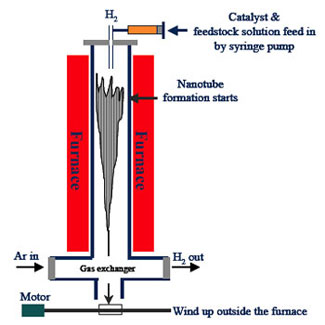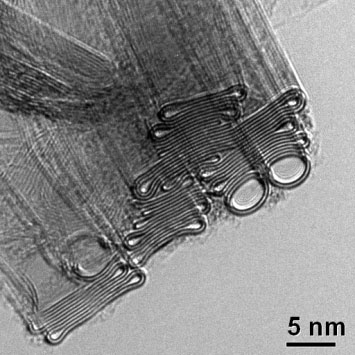| Posted: Nov 20, 2007 | |
Nanotechnology fibers will revolutionize materials engineering |
|
| (Nanowerk Spotlight) Tie a rock to the end of a piece of ribbon, then spin it over your head. It will be pulled taut as the rock circles about. Now, imagine a ribbon 62,000 miles long, anchored near the equator with a weight on the other end. The centrifugal force of the earth's rotation will make it behave the same way. You'll end up with not only the world's biggest nunchuck, but also a kind of elevator to outer space. | |
| A space elevator is one of those ideas from 1950s-style futurism that are so whacky they might just work. The single most difficult task in building the Space Elevator is achieving the required tether strength-to-weight ratio - in other words, developing a material that is both strong enough and light enough to support the 60,000 mile long tether. This material has become available in the form of carbon nanotubes (CNTs). The challenge ahead is to weave these raw CNTs into a useful form - a space worthy climbable ribbon. | |
| Assembling carbon nanotubes into commercially usable fibers is still one of the many challenges that nanotechnology researchers are faced with when trying to exploit the amazing properties of many nanomaterials. Apart from ambitious large-scale projects like the space elevator, CNT-based fibers will have many applications, from protective fabrics and coatings in military applications, higher performance materials for sports equipment to transparent conductive films and, eventually, as a replacement for copper wire in transmitting electrical power and signals. | |
| Researchers in the UK are making good progress in developing scalable fabrication techniques for high performance CNT fibers. | |
| "Single- and double-wall carbon nanotubes (SWCNTs and DWCNTs) are promising candidates to serve as building blocks for a new generation of high-performance fibers" Dr. Alan Windle explains to Nanowerk. "Both theoretical models and experimental data show that the axial strength and stiffness of individual SWNTs are of the order of 50 GPa and 1 TPa, respectively. However, their assembly into useful forms, such as macroscopic fibers, with properties which reflect a significant proportion of those seen in the individual tubes, remains a well-defined challenge to materials processing. | |
| Windle, a Professor of Materials Science at the University of Cambridge in the UK, and his group, the Macromolecular Materials Laboratory, have recently introduced a method for the direct spinning of pure carbon nanotube fibers from an aerogel formed during chemical vapour deposition ("Direct Spinning of Carbon Nanotube Fibers from Chemical Vapor Deposition Synthesis"). In follow-up work, the Cambridge scientists have shown that the mechanical properties of the fibers are directly related to the type of CNTs present (i.e., multi-walled or single-walled), which in turn, can be controlled by the careful adjustment of process parameters ("Mechanical Properties of Continuously Spun Fibres of Carbon Nanotubes"). | |
 |
|
| Whereas previously, scientists were only able to turn carbon nanotubes into fibers using post-processing techniques, the process developed by the Cambridge scientists allows for the nanotubes to be created and spun into filaments in a single process. Schematic diagram of the direct spinning process for CNT fibers as described in the paper "Direct Spinning of Carbon Nanotube Fibers from Chemical Vapor Deposition Synthesis" (Reprinted with permission from Wiley-VCH Verlag) | |
| As in the proverb 'A chain is only as strong as its weakest link', the performance of a CNT fiber depends on the weak points along its length, caused by defects on its internal structure. The major challenge for materials engineers therefore is to develop a production process that avoids these defects and makes CNT fibers suitable for commercial applications. | |
| "We have developed successful strategies to avoid particulate defects amongst the network of nanotube bundles forming the fibers" Dr. Marcelo S. Motta, a Research Associate in Windle's group, tells Nanowerk. "Recent improvements in our process have enabled us to spin continuously with iron contents down to 25 ppm. At present, these fibers are spun at a rate of 5?25 meters per minute, with diameters in the range 2?20 µm. Because they are so thin, a kilometer of fiber weighs much less than a gram." | |
| Motta recently first authored a paper in Advanced Materials where the Cambridge scientists describe their fabrication technique for high performance CNT fibers and relate the performance to unique aspects of fiber microstructure ("High Performance fibers from Dog Bone Carbon Nanotubes"). | |
| "In particular we have developed successful strategies to avoid particulate defects amongst the network of nanotube bundles forming the fibers" says Motta. | |
 |
|
| HRTEM image of a bundle close to a fibre fracture revealing that the bundles consist, predominantly, of collapsed double-wall nanotubes greater than 5 nm. Note both the 'dog-bone' cross section of these tubes and the non-collapsed tubes at the edge of the bundle. Also present is a collapsed triple-wall tube (14 nm equivalent diameter) in the center of the image and a few collapsed single-wall tubes greater than 4.5 nm. (Reprinted with permission from Wiley-VCH Verlag) | |
| The research of Windle's team was subject to a story in BBC News (Coming of age for 'future fibers') where the researchers decsribe possible future applications of superstrong CNT fibers. Apart from the obvious uses that exploit the mechanical properties, their high electrical conductivity could potentially rival copper for power transmission, possibly leading to less power being lost in transmission. | |
| Another aspect that could make these materials interesting for potential industrial applications is the simplicity of the fabrication technique, leading to production costs that are much lower than for existing high-performance fibers. | |
 By
Michael
Berger
– Michael is author of three books by the Royal Society of Chemistry:
Nano-Society: Pushing the Boundaries of Technology,
Nanotechnology: The Future is Tiny, and
Nanoengineering: The Skills and Tools Making Technology Invisible
Copyright ©
Nanowerk LLC
By
Michael
Berger
– Michael is author of three books by the Royal Society of Chemistry:
Nano-Society: Pushing the Boundaries of Technology,
Nanotechnology: The Future is Tiny, and
Nanoengineering: The Skills and Tools Making Technology Invisible
Copyright ©
Nanowerk LLC
|
|
|
Become a Spotlight guest author! Join our large and growing group of guest contributors. Have you just published a scientific paper or have other exciting developments to share with the nanotechnology community? Here is how to publish on nanowerk.com. |
|
